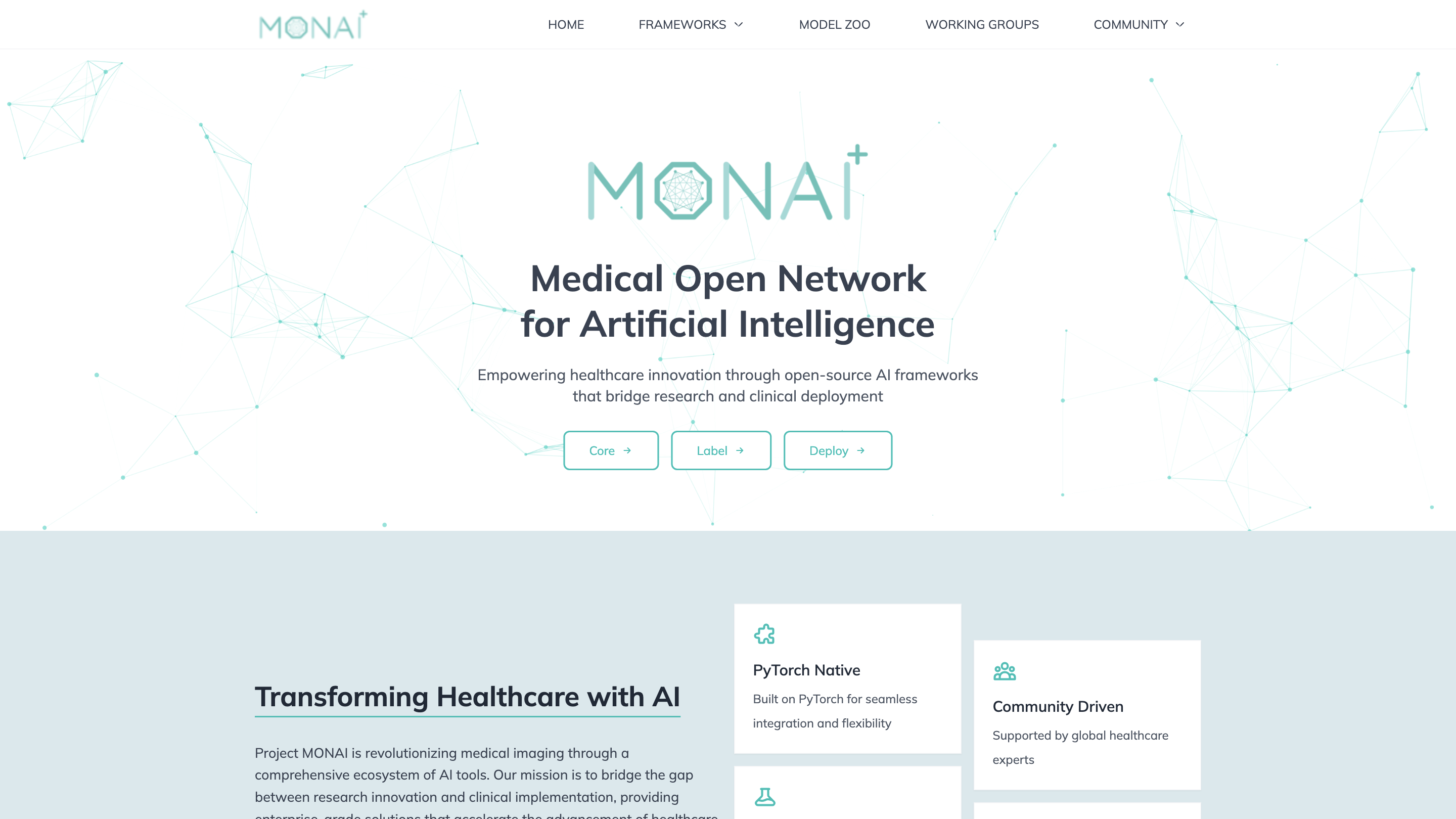MONAI
Open siteIntroduction
PyTorch-based healthcare imaging framework
MONAI Product Information
MONAI (Medical Open Network for AI) is an open-source AI framework ecosystem designed to bridge research innovation and clinical deployment in healthcare. Built on PyTorch, MONAI provides enterprise-grade tools to accelerate medical imaging AI development, validation, and production across the entire lifecycle—from data annotation to clinical deployment.
Overview
MONAI offers a comprehensive ecosystem including MONAI Core, MONAI Label, MONAI Deploy, and a pre-trained Model Zoo. With a strong emphasis on standardization, research-readiness, and community-driven collaboration, MONAI enables researchers and healthcare professionals to build, train, and deploy medical AI models with reproducibility and interoperability in mind. The project is Apache 2.0 licensed for maximum flexibility and collaboration.
Core Components
- MONAI Core: Domain-specific framework for training state-of-the-art medical imaging AI models with medical transforms and architectures (e.g., UNETR). Provides a research-ready stack.
- MONAI Label: AI-assisted image annotation with active learning, multiple viewer integrations, and multi-user collaboration for efficient data labeling.
- MONAI Deploy: Robust framework for deploying AI models in clinical settings, including clinical workflow integration, DICOM & FHIR support, and containerized deployment with MAP for inference optimization.
- Model Zoo: Central collection of pre-trained models and automated ML pipelines to accelerate experimentation and deployment.
- End-to-End Medical AI Lifecycle: Tools cover data annotation, model training, evaluation, deployment, and monitoring to ensure quality and consistency at every stage.
Key Features
- End-to-end lifecycle support from data annotation to clinical deployment
- PyTorch-native for seamless integration and flexibility
- Research-ready with standardized best practices for healthcare AI
- Open-source with Apache 2.0 licensing for freedom and collaboration
- Containerized deployment and MAP-based inference optimization for clinical use
- DICOM and FHIR compatibility for healthcare data integration
- Active learning and multi-user collaboration in MONAI Label
- Rich model zoo and automated ML pipelines for rapid experimentation
- Strong emphasis on reproducibility, validation, and governance
Why MONAI
- Accelerates healthcare innovation by providing a cohesive, interoperable set of tools that connect research to clinical deployment.
- Fosters a global community of researchers, developers, and healthcare professionals contributing to, and benefiting from, shared standards and workflows.
- Demonstrates real-world impact through case studies and enterprise deployments (e.g., Mayo Clinic integration, Siemens Healthineers collaborations).
How It Works
- Develop and validate models with MONAI Core using medical imaging datasets and transforms.
- Annotate data efficiently with MONAI Label, leveraging active learning and AI-assisted labeling.
- Deploy models into clinical environments with MONAI Deploy, integrating with existing workflows and data standards (DICOM, HL7/FHIR).
- Access and reuse pre-trained models from the Model Zoo to accelerate development.
Getting Involved
- Explore and contribute via MONAI GitHub, Discussions, Slack, and community events.
- Access tutorials, demos, and notebooks to learn best practices and implementation patterns.
Use Cases
- Medical image segmentation, detection, and classification in radiology, pathology, and related domains.
- AI-assisted annotation and labeling for large-scale medical imaging studies.
- Clinical-ready AI deployment with governance, monitoring, and interoperability.
Safety and Ethics
- MONAI emphasizes reproducibility, validation, and alignment with clinical workflows to support safe and effective healthcare AI deployment.
Core Features
- PyTorch-native framework for seamless research-to-production transitions
- MONAI Label for AI-assisted annotation and active learning
- MONAI Deploy for clinical-grade deployment with DICOM & FHIR support
- Model Zoo with pre-trained models and automated ML pipelines
- End-to-end lifecycle tools from data prep to deployment
- Containerized deployments and MAP inference optimization
- Strong community and open-source governance under Apache 2.0
